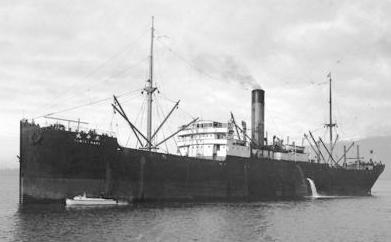RIKUGUN YUSOSEN
 (TEMPEI (TAIHO) MARU at Vancouver, 1934)
(TEMPEI (TAIHO) MARU at Vancouver, 1934)
TEMPEI (ex-TAIHO) MARU:
Tabular Record of Movement
© 2014-2016 Bob Hackett
Revision 1
E 1918:
Sakurashima. Laid down at Osaka Iron Works Co., Ltd as Yard No. 950,
a 6,097-ton passenger-cargo ship for Uchida Kisen K.K. of Tarumi.
December 1918:
Launched and named TAIHO MARU.
December 1918:
Completed.
1920:
Sold to Kokusai Kisen K. K (International Steamship Co. Ltd.) of Kobe.
31 March 1921:
TAIHO MARU arrives at Ellis Island, New York from
Gibraltar.
1 January 1925:
TAIHO MARU arrives at Ellis Island.
1920 - 1929:
In International Steamship Co.'s service.
1929:
Sold to Hakuyo Kisen K. K. of Kyoto and Fuchu. Renamed TEMPEI MARU.
January 1934:
Arrives at Vancouver, B.C., Canada.
24 January 1934:
Departs Vancouver for Brisbane and Sydney,
Australia.
1 March 1934: Brisbane. Captain T. Marumoto’s TEMPEI MARU enters the
Brisbane River under tow with a 15 degree list to port. Berths at Brett's Wharf,
Hamilton. Most of the coal in the bunkers has been used up, and some of the
contents of the water ballast tanks had been used, so that the vessel is light
below the deck, A heavy deck cargo of logs and timber made the ship top heavy
and towards the end of the voyage a list developed. When berthed she has about
120 tons of coal left, enough for only three days' steaming.
1 December 1941:
Requisitioned by the Imperial Army (IJA) and
converted to a troop transport. Allotted Army No. 146.
18 December 1941: The Invasion of the Philippines -“M” Operation (M
Sakusen):
At 1700, TEMPEI MARU departs Takao, Formosa for Lingayen Gulf,
Philippines in Rear Admiral (later Vice Admiral) Rear Admiral Hara Kensaburo's
(37)(former CO of TAKAO) 1st Lingayen Invasion Unit with 27 other IJA transports
escorted by DesRon 5's light cruiser NATORI, DesDiv 5's ASAKAZE, HARUKAZE and
MATSUKAZE, DesDiv 22's FUMIZUKI, MINAZUKI, NAGATSUKI and SATSUKI, minesweepers
W-15 and W-16 and subchasers CH-1, CH-2, CH-3 CH-13, CH-14 and CH-15.
The Japanese main invasion at Lingayen Gulf consists of three transport
echelons and carries the main part of LtGen Homma Masaharu's 80,000-man 14th
Army. The first echelon is composed of 27 transports from Takao under Rear
Admiral Hara , the second echelon of 28 transports under Rear Admiral (later
Vice Admiral) Nishimura Shoji (39) and the third echelon of 21 transports from
Keelung under Rear Admiral (later Vice Admiral) Hirose Sueto (39).
24 December 1941:
Lingayen Gulf. Between 0110 and 0430, the Lingayen
Invasion Convoy lands troops at Lingayen.
E January 1942:
Arrives at Camranh Bay, Vichy French, Indochina to
mobilize for the Invasion of Java.
18 February 1942: Operation "J" - The Invasion of Java, Netherlands East
Indies:
TEMPEI MARU is attached to Rear Admiral (later Vice Admiral) Hiraoki,
Kumeichi’s (39) 9th Base Force in Vice Admiral Ozawa Jisaburo’s Western Java
Seizure Force. At 1000, departs Camranh Bay in a convoy also comprised of 55
troop transports.
The transports carry the 2nd Infantry Division for the invasions of
Merak, Bantam Bay and Eretan, Java escorted by light cruisers NATORI, and YURA
and DesDivs 5, 6, 11, 12 and 22. Seaplane tender SANYO MARU provides air cover.
Forty-five transports go to Merak and Bantam Bay Java.
28 February 1942:
S of Merak, Java. At 2320, TEMPEI MARU and 29 other
transports carrying MajGen Nasu Yumio’s and Colonel Fukushima Kyusaku’s
detachments of L tGen Maruyama Masao’s 2nd Infantry Division commence landing
their troops.
12 January 1944:
At 0805, TEMPEI MARU departs Sabang for Merak in a
convoy also consisting of transports DAICHO and ZUISHO MARUs escorted by minelayer
HATSUTAKA. Enroute, HATSUTAKA is detached.
15 May 1944:
TEMPEI MARU departs Manila for Halmahera Island in
convoy H-26 also consisting of AKAGISAN, DAIJUN, ETAJIMA, KENWA, TAIYU, TOUN and
SHIRAHAMA MARUs and SHINSEI MARU No. 1 escorted by minelayer YAEYAMA and
subchasers CH-45 and CH-47. The convoy carries the 110th Airfield Battalion, 117th, 119th, 120th and 122nd Airfield Battalions, 123rd and 124th Field Airfield Construction
Units. The two Field Airfield Construction Units were semi-mechanized units (equipment one prime mover and 13 trucks each) and were consisted of about 149-179 soldiers and civilians each. Each field airfield construction
unit would supervise 1,000-2,000 local employees.
17 January 1944:
Arrives at Batavia (Jakarta), Java.(Indonesia).
22 May 1944:
Off Davao, Philippines. At about 0100, LtCdr (later Rear
Admiral-Ret) Brooks J. Harral's (USNA ’32) USS RAY (SS-271) makes a
radar-assisted surface night attack on the convoy. In a series of attacks,
Harral fires six torpedoes at overlapping targets and hits TEMPEI MARU carrying
a cargo of gasoline and rice. The gasoline erupts in flames. She sinks at
05-16S, 127-42E. 11 passengers, five gunners and 19 crewmen are KIA.
At 2025, Allied codebreakers decrypt a message from YAEYAMA that reads: “At 0100, in position 05-16N, 127-42E, TEMPEI MARU was torpedoed and blew up --.”
Authors Notes:
[1] Also known as TENPEI MARU.
Thanks go to Erich Muehlthaler of Germany and the late John Whitman.
- Bob Hackett
Back
to IJA Transports





